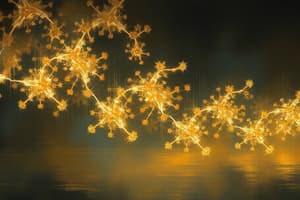Podcast
Questions and Answers
Which type of chemical bond involves the sharing of electron pairs between atoms?
Which type of chemical bond involves the sharing of electron pairs between atoms?
- Metallic bond
- Ionic bond
- Hydrogen bond
- Covalent bond (correct)
What unique property of noble gases makes them suitable for use in providing an inert atmosphere?
What unique property of noble gases makes them suitable for use in providing an inert atmosphere?
- Stable outer electron shell (correct)
- Unstable outer electron shell
- Ability to conduct electricity
- Highly reactive nature
Which of the following halogens is a gas at room temperature?
Which of the following halogens is a gas at room temperature?
- Astatine
- Fluorine (correct)
- Bromine
- Iodine
What characteristic makes alkali metals the most reactive of all metals?
What characteristic makes alkali metals the most reactive of all metals?
Which physical property describes how easily a material can conduct an electrical current?
Which physical property describes how easily a material can conduct an electrical current?
What phenomenon occurs when iron or steel undergoes corrosion?
What phenomenon occurs when iron or steel undergoes corrosion?
What is an ion?
What is an ion?
Which property determines how easily a substance can ignite and burn?
Which property determines how easily a substance can ignite and burn?
What charge does an atom acquire when it loses one or more electrons?
What charge does an atom acquire when it loses one or more electrons?
Which of the following best describes a diatomic molecule?
Which of the following best describes a diatomic molecule?
Which of the following statements is true regarding compounds?
Which of the following statements is true regarding compounds?
What is the total number of atoms in the chemical formula Na2CO3?
What is the total number of atoms in the chemical formula Na2CO3?
Which group in the periodic table contains metals that become more reactive as you move down the group?
Which group in the periodic table contains metals that become more reactive as you move down the group?
Which of the following elements is NOT a compound?
Which of the following elements is NOT a compound?
Halogens are known for forming which type of bond primarily?
Halogens are known for forming which type of bond primarily?
What distinguishes elements from compounds and molecules?
What distinguishes elements from compounds and molecules?
Flashcards are hidden until you start studying
Study Notes
Chemical Bonding
- The process of atoms holding together in compounds.
- Three main types: ionic, covalent, and metallic.
Noble Gases
- Unreactive and monatomic due to stable outer electron shells.
- Used in providing inert atmospheres: Argon in lamps and Helium in balloons.
Halogens
- Range from gases (Fluorine, Chlorine) to liquids and solids down the group.
- Increasing atom size down the group due to more energy levels.
- Diverse uses in medicine, industry, and household products.
Alkali Metals
- Most reactive metals due to losing one electron for a stable outer shell.
### Physical Properties
- Luster: How shiny a substance is.
- Solubility: How easily a substance dissolves (e.g., table salt dissolving in water).
- Conductivity: How easily electrical current and heat pass through.
- Good conductors (Copper wire) allow easy flow.
- Poor conductors (insulators) resist flow (e.g., rubber).
- Ductility: How easily a substance bends.
- Most metals are ductile at high temperatures.
- Non-ductile materials (glass) are brittle and break easily when stretched.
Chemical Properties
- Describe the ability of a substance to change into new substances.
Reactivity
- Chemicals can react with other materials.
- Metals react with acids, producing new substances and gases (e.g., Magnesium reacting with acid, releasing hydrogen gas).
Flammability
- How easily a substance catches Fire (e.g., paper, gasoline).
- Burning involves chemical reactions, transforming substances into different ones.
Corrosion
- Iron and Steel corrosion is called "rusting."
- Rust is the red-brown substance formed.
Ions
- Charged particles with unequal numbers of protons and electrons.
- Formed by gaining or losing electrons.
- Cation: Positively charged ion (more protons than electrons).
- Anion: Negatively charged ion (more electrons than protons).
Diatomic Molecules
- Molecules composed of two atoms, either identical or different elements.
Elements
- Single atoms of elements are not molecules.
- Molecules are formed when elements bond to themselves or other elements (e.g., O2, O3, CO2).
Compounds
- Pure substances made of two or more different elements joined by chemical bonds.
- Chemical bonds can only be broken by other chemicals, not physically separated.
Example Tables
- Demonstrates the composition of molecules and compounds, including number of atoms, molecules, and elements.
Example 2: Dot and Cross Diagrams
- Illustrates how elements form bonds and the ions they create.
Periodic Table
- Non-metals are on the right side, metals on the left.
- Metals become more reactive down a period.
- Non-metals become less reactive down a period.
Groups
- Group 1: Alkali metals
- Group 2: Alkaline Earth metals
- Group 7: Halogens
- Group 8 (Group 0): Noble Gases
Let's Practice
- Correct Answer: c. Covalent
- Halogens primarily form covalent bonds.
- Correct Answer: a. They are Metals
- Halogens are non-metals.
- Correct Answer: a. All form only -1 anions
- Halogens can form anions with different charges.
Studying That Suits You
Use AI to generate personalized quizzes and flashcards to suit your learning preferences.



